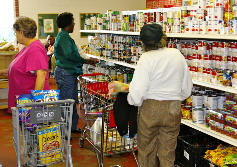by Ann Cipperly
Wen Martha Henk was grow- ing up in the Congo with her missionary parents, she developed a heart of caring at an early age, seeing children with enlarged stomachs and hair turned red from lack of nutrition. At the time, she never dreamed the com- passion she felt would one day be a call- ing. Since 1995, Martha has served as the executive director of the Food Bank of East Alabama as it has expanded from serving several thousand to 57,200 individuals in food-insecure households, with 16,480 of those being children.
Martha’s parents, Wally and Ruth Henk, were missionaries in the Congo for 17 years and were the biggest influence on her life. She grew up watching her parents’ commit- ment to helping people in need.
 While childhood was filled with unusual experiences as her family traveled through- out Africa, at times her family faced dan- ger. Bands of soldiers would take over the mission station and hold them at gunpoint. Soldiers ransacked their home and would take what they wanted.
While childhood was filled with unusual experiences as her family traveled through- out Africa, at times her family faced dan- ger. Bands of soldiers would take over the mission station and hold them at gunpoint. Soldiers ransacked their home and would take what they wanted.
When Martha was 16 years old, she and her family were evacuated from the Congo under gunfire. Snipers at the airport fired at them as they waited for the United Nations plane. They moved from Africa to Minnesota where her father served as a minister.
After Martha married, she lived in Delaware a few years where her three children were born. Her family moved to Auburn in 1982, with her parents and sister soon following.
Martha had worked five years with the Presbyterian Community Ministries when he was approached to become executive director of the Food Bank of East Alabama in 1995. Martha felt she didn’t know anything and asked to visit a food bank.
She was sent to the food bank in Montgomery and was told they could teach about pest control and food handling but couldn’t teach her to have a heart for the work. “That was the one thing I knew,” Martha says. “I had a strong sense of call, and I knew if I didn’t take the job, I would be missing out on something I was supposed to do. That sense of call has been wonderful to carry me through some tough times.
“I feel that the work that I am involved in is mission work just like the mission work my parents did,” she adds. “Work on the mission field is responding to a certain need just as I am responding to a need.”
Needs at the Food Bank are increasing this fall. The food supply is down with lingering supply chain issues. Food drives have not returned to pre-pandemic numbers. Not only is the Food Bank dealing with increased prices for food, but substantial increased transportation costs. Everything is more expensive.
Some of the additional support that was available during the pandemic for families has ended. This affects a family’s ability to provide food.
“We are incredibly blessed to be in the community we have,” Martha says, “because we have had really good support from the Tallapoosa and Lee County commission and City of Auburn and City of Opelika. They have supplied some of the Covid relief money that we have been using to purchase additional food. The City of Auburn has also provided some of their CARES funds for us to get a truck and fork lift that really makes a difference.
People often ask Martha the difference between the Food Bank and food pantries. “The food bank’s job is to gather together the best supply of food we can and make that available to churches and non-profits,” she says. “When the food comes to us, we get it into the community. The food pantries are the ones that actually get food to people who need it. More than 200 agencies are imbedded in our community who know where the people are and how to get food to those who need it. They are our heroes.”
 Along with food pantries, other places supplying food include soup kitchens, shelters, rehab programs and others. “We are the middle person in the process,” Martha says. “If someone contacts us or comes in needing food, we send them to food pantries closest to them.”
Along with food pantries, other places supplying food include soup kitchens, shelters, rehab programs and others. “We are the middle person in the process,” Martha says. “If someone contacts us or comes in needing food, we send them to food pantries closest to them.”
The Food Bank of East Alabama covers seven counties. Last year nearly five million pounds of food was distributed, and an average of 42,450 people were provided food assistance every month. “Each one represents a neighbor, whether it is a senior struggling with health issues or a child out of school and not having access to school lunches they are used to having.
“There are families in different kinds of crises. Food insecurity and poverty are not the same thing, but they always go hand and hand. If you find poverty, you are always going to find levels of food insecurity. The best benefit of food banks is if we can get food to people who need it, then they can use their limited resources toward paying rent or medical bills.”
Financial support allows the food bank to purchase the kinds of food needed. However, it doesn’t provide variety, which makes food drives more important than they have been before.
Martha often refers to the quote by Desmond Tutu, “Do your little bit of good where you are; it’s these little bits of good put together that overwhelm the world.”
She points out the difference Kroger in Opelika and Auburn have made by providing Food Bank barrels for shoppers to drop food in as they are leaving the store. “People think they can’t make a difference in feeding 57,000,” Martha says “but one family can help another family by picking up an extra jar of peanut butter to put in the barrel, dropping it off at the Food Bank or one of the food drives. If each one of us does that, it has a tremendous impact.”
The Food Bank starts programs as needs are discovered. The backpack programs for children started because there was a school nurse who kept seeing children on Mondays with stomachaches and headaches. When the nurse talked to the children, she learned they were eating breakfast and lunches at school, but they were not getting enough food on weekends.
Now the food bank backpack program is in 13 schools in elementary and primary. Breakfast, lunch and dinner, as well as snacks, are tucked into backpacks on Fridays.
The Food Bank also collects for senior citizens’ boxes. Martha started the brown bag meals program in 1997 when she found a lady in Opelika eating canned cat food and rice for her meals. When she started the program, Martha was told it wasn’t going to work as it is such a big problem. “Just because you can’t do it all, that does not stop you from doing anything,” she says. “You can’t be discouraged. The program has continued to grow.”
While the Food Bank has a staff of 18 workers, volunteers are needed. Last year, 23,741 volunteer hours were provided. There are many ways to volunteer. One lady who wanted to help began making cards of encouragement to place in the senior bags.
 Recently, a little boy named Barrett stopped by the Food Bank with $100 from sales at a lemonade stand. Martha was able to tell the little boy that every dollar they receive can buy seven meals, which meant he was providing 700 meals for those in need.
Recently, a little boy named Barrett stopped by the Food Bank with $100 from sales at a lemonade stand. Martha was able to tell the little boy that every dollar they receive can buy seven meals, which meant he was providing 700 meals for those in need.
One new program provides fresh produce from farmers of small or minority owned farms. There is no cost, and USDA pays for the product. “We had a couple of farmers tell us they were getting close to going out of business,” Martha states, “and this has helped them stay in business. We have been getting fresh fruits and greens for our community pantries.
“When we are worried that our food drives are down and we are getting less fromthenationalfoodbank,welookatthe
fresh produce and eggs that are not going to cost anything.”
Thanksgiving and Christmas present a particular challenge as there are so many needs. One church is helping by filling holiday boxes for families, and the City of Auburn started years ago asking employees to take a turkey to work to donate. Others who receive a turkey or ham at their work will donate them, and EAMC donates turkeys leftover from employee giveaways. Turkey and trimmings are ideal for making a family’s holiday meal special.
“We are focusing on how we do this with dignity,” Martha adds, “and how we let people know that this is not something to be ashamed of and not be judgmental. The truth is any one of us could be in that situation.”
The Community Market of East Alabama, one of the pantries, functions as an extension of the Food Bank to provide direct food-relief to low-income residents of Lee County. It is a model program that offers client-choice shopping in a grocery-store atmosphere at a convenient location on Pepperell Parkway in Opelika.
“While the ‘new’ Food Bank has a wonderful facility, we now turn our attention to the Community Market,” Martha states. “The reality is that the Community Market has long since outgrown its building.
Additional concerns include inadequate parking space, the challenges for clients pulling out onto a very busy road, and the aging of the building.
“Last year an opportunity opened up for the Food Bank to purchase land for building a new facility for Community Market’s operations. We are working on design plans now. At this time we do not have a timeline developed for this construction, but we anticipate work getting underway as funding allows us to move ahead with our plans.”
Martha feels it is a privilege to be at the Food Bank. “I was privileged to grow up in a family with a mother and father who were both very service oriented. They never said why doesn’t someone do something for me, as they were always looking to see what they needed to do. I am just so privileged to be in a line of work that I can do as mission work being done locally, not overseas.
“I think we are built with a need to do something for others. Whether it is helping someone read with the Literacy Coalition, helping families in domestic violence or the Food Bank, find what sparks your heart, and it will be a privilege to be able to do that.”
For additional information on the Food Bank, visit www.foodbankofeastalabama.com







